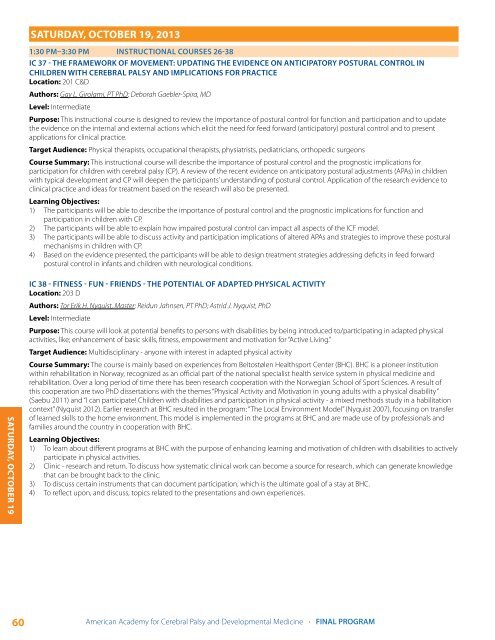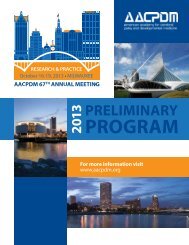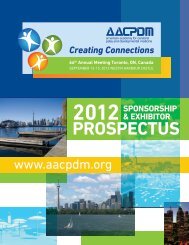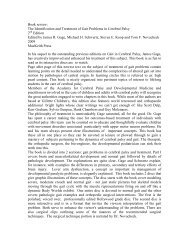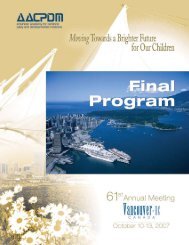ProgrAm - American Academy for Cerebral Palsy and ...
ProgrAm - American Academy for Cerebral Palsy and ...
ProgrAm - American Academy for Cerebral Palsy and ...
- No tags were found...
You also want an ePaper? Increase the reach of your titles
YUMPU automatically turns print PDFs into web optimized ePapers that Google loves.
Saturday, October 19, 20131:30 pm–3:30 pm Instructional Courses 26-38IC 37 - THE FRAMEWORK OF MOVEMENT: UPDATING THE EVIDENCE ON ANTICIPATORY POSTURAL CONTROL INCHILDREN WITH CEREBRAL PALSY AND IMPLICATIONS FOR PRACTICELocation: 201 C&DAuthors: Gay L. Girolami, PT PhD; Deborah Gaebler-Spira, MDLevel: IntermediatePurpose: This instructional course is designed to review the importance of postural control <strong>for</strong> function <strong>and</strong> participation <strong>and</strong> to updatethe evidence on the internal <strong>and</strong> external actions which elicit the need <strong>for</strong> feed <strong>for</strong>ward (anticipatory) postural control <strong>and</strong> to presentapplications <strong>for</strong> clinical practice.Target Audience: Physical therapists, occupational therapists, physiatrists, pediatricians, orthopedic surgeonsCourse Summary: This instructional course will describe the importance of postural control <strong>and</strong> the prognostic implications <strong>for</strong>participation <strong>for</strong> children with cerebral palsy (CP). A review of the recent evidence on anticipatory postural adjustments (APAs) in childrenwith typical development <strong>and</strong> CP will deepen the participants’ underst<strong>and</strong>ing of postural control. Application of the research evidence toclinical practice <strong>and</strong> ideas <strong>for</strong> treatment based on the research will also be presented.Learning Objectives:1) The participants will be able to describe the importance of postural control <strong>and</strong> the prognostic implications <strong>for</strong> function <strong>and</strong>participation in children with CP.2) The participants will be able to explain how impaired postural control can impact all aspects of the ICF model.3) The participants will be able to discuss activity <strong>and</strong> participation implications of altered APAs <strong>and</strong> strategies to improve these posturalmechanisms in children with CP.4) Based on the evidence presented, the participants will be able to design treatment strategies addressing deficits in feed <strong>for</strong>wardpostural control in infants <strong>and</strong> children with neurological conditions.Saturday, October 19IC 38 - FITNESS - FUN - FRIENDS - THE POTENTIAL OF ADAPTED PHYSICAL ACTIVITYLocation: 203 DAuthors: Tor Erik H. Nyquist, Master; Reidun Jahnsen, PT PhD; Astrid J. Nyquist, PhDLevel: IntermediatePurpose: This course will look at potential benefits to persons with disabilities by being introduced to/participating in adapted physicalactivities, like; enhancement of basic skills, fitness, empowerment <strong>and</strong> motivation <strong>for</strong> “Active Living.”Target Audience: Multidisciplinary - anyone with interest in adapted physical activityCourse Summary: The course is mainly based on experiences from Beitostølen Healthsport Center (BHC). BHC is a pioneer institutionwithin rehabilitation in Norway, recognized as an official part of the national specialist health service system in physical medicine <strong>and</strong>rehabilitation. Over a long period of time there has been research cooperation with the Norwegian School of Sport Sciences. A result ofthis cooperation are two PhD dissertations with the themes “Physical Activity <strong>and</strong> Motivation in young adults with a physical disability”(Saebu 2011) <strong>and</strong> “I can participate! Children with disabilities <strong>and</strong> participation in physical activity - a mixed methods study in a habilitationcontext” (Nyquist 2012). Earlier research at BHC resulted in the program: “The Local Environment Model” (Nyquist 2007), focusing on transferof learned skills to the home environment. This model is implemented in the programs at BHC <strong>and</strong> are made use of by professionals <strong>and</strong>families around the country in cooperation with BHC.Learning Objectives:1) To learn about different programs at BHC with the purpose of enhancing learning <strong>and</strong> motivation of children with disabilities to activelyparticipate in physical activities.2) Clinic - research <strong>and</strong> return. To discuss how systematic clinical work can become a source <strong>for</strong> research, which can generate knowledgethat can be brought back to the clinic.3) To discuss certain instruments that can document participation, which is the ultimate goal of a stay at BHC.4) To reflect upon, <strong>and</strong> discuss, topics related to the presentations <strong>and</strong> own experiences.60<strong>American</strong> <strong>Academy</strong> <strong>for</strong> <strong>Cerebral</strong> <strong>Palsy</strong> <strong>and</strong> Developmental Medicine • FINAL PROGRAM


